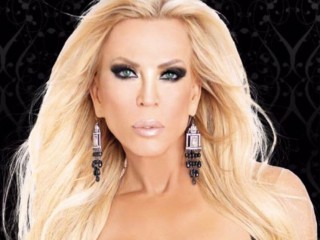Fashion is Fickle and Now Smaller Busted Female Bodies are in Vogue.
Breasts. They are the glory and the bane of anyone assigned female at birth. In a culture that has long held impossible to achieve beauty standards, the size and shape of a woman’s breasts have come under constant scrutiny. Depending on the era, the pursuit of what has been considered most desirable has sent women running for bandeau brassieres, bullet bras, Wonder Bras, underwire bras, sports bras, no bras, corsets that lift, corsets that flatten, and even enlargement surgery.
According to the NY Times, liposuction is the most popular of the cosmetic surgeries for women, with breast augmentation coming in second. Approximately 300,000 women opt to boost their bra size each year. Fewer women have been interested in downsizing, but the number is increasing. The American Society of Plastic Surgeons says that there has been a 64 percent increase in the number of elective breast reduction surgeries since 2019. During 2023, there were more than 76,000 such procedures in addition to post-mastectomy breast reconstruction and gender-affirming top surgeries.
Women of all ages are taking advantage of the newest technologies in plastic surgery, which is a highly lucrative business. Because of this and some of the reasons that women have their breasts made smaller, there is concern that negative social attitudes about breasts may be more of a problem than the breasts themselves.
Back pain, neck pain, shoulder pain, skin rashes, difficulties with movement, and engaging in sports or exercise are reasons that women may be able to get insurance to cover reduction surgeries as “medically necessary.” But first, the patient must prove she has done everything she can to alleviate his pain with nonsurgical means such as over the counter pain meds, support bras, or physical therapy.
Those considered elective surgeries rarely receive full coverage, if they’re covered at all. A Health Cost Institute analysis found that cosmetic minimization of breasts makes up most reductions and the number of women under the age of 30 who seek them is increasing.
Lingerie makers are intimately familiar with breasts and breast sizes. In 2013, a survey by one such company found that the average American cup size was DD. Most women who opt for a breast reduction wish theirs were that small. In addition to any shame about the size of their breasts patients sometimes report is a general loathing for the shape of their breasts. When they are not perky, plump, or have a well-centered nipple, their condition is often said to make the women who have them feel older than they are.
Anyone who has spent any time looking at breasts knows that they come in many shapes and sizes, some with a droop, some flat and large, others soft and overly pliable. Regardless of how they look before surgery, women consistently confide that they grew up with both adults and age peers who felt comfortable sharing their unsolicited opinions about them. Those with naturally large breasts, especially when young, report that they have long been oversexualized and their character is sometimes called into question because of them.
Activities like figure skating, gymnastics, snowboarding, hiking, dancing, and jogging are often painful or embarrassing. To minimize these difficulties, some bind their breasts with sports bras. Big-busted women who like to swim or wear sexy bras find it difficult to locate either. Some suits and bras come with thick support straps, which defeat the purpose. Because of this, it is not uncommon for large-breasted women to cover themselves in bulky tops, jackets, or dresses that minimize their visible bust or cleavage.
A study published on Science Direct found that slightly more than 70 percent of women worldwide were unhappy with the size of their breasts. What drives a woman to reduce rather than enlarge her breasts is likely quite different, but both surgeries involve anesthesia, time off from work, pain, scars, and a recovery period. For those who seek to drop down a cup size or three, there are additional lifestyle sacrifices. According to the National Library of Medicine, women who have had reduction surgery are more than three times less likely to be able to breastfeed as compared to women without such surgery.
Today’s women between the ages of 18 and 34 are not like the women who came before them. The Pew Research Center discovered that more than half say they do not plan to have children or are uncertain. By comparison, men are much more likely to want to be a parent someday.
Perhaps this is one reason that many women have felt judged by their plastic surgeons, 80 percent of whom are men. Women who frequent Reddit’s r/Reduction have shared complaints that include unwanted comments about their weight, expressions of a doctor’s personal preference for “cute and round” breasts, and a deep concern about what husbands or boyfriends would rather they look like.
Nonetheless, the idea of smaller and more manageable breasts continues to appeal to women. While some think that platforms like TikTok, Instagram, or YouTube, with content explaining or promoting smaller breasts, the surgery necessary to obtain them, and before/after photos, is responsible for the growing preference for more diminutive breasts, women continue to show their surgeons photos of celebrities who personify their desired look and cute garments they want to be able to wear with confidence.
@nosarellla Lets just say a weight has been lifted…no implants all natural. •Dr. Paulsen at St Francis Hospital in Tulsa Oklahoma. •Instagram Plasticsurgerytulsa •Breast Reduction: Included a lift. •Was a size I •Will not know size until a year from now #breastreductionthings #breastreduction #surgerytiktok #surgery #reduction #fyp #happy #beforeandafter #tulsa ♬ Nasty - Tinashe
Jerry Chidester, a plastic surgeon in Salt Lake City, UT says his patients don’t just want smaller breasts, they want much smaller breasts. Where requests for C cups were once the norm, today’s customers want B cups.
The question remains, is this rise in breast reduction surgeries an unhealthy reaction to being sexualized or marginalized? Is it a rejection of unwelcome male gazes? Is it an act of defiance against the impossible ideal of the “perfect” breast? Or is it what women claim, a desire for physical autonomy, greater comfort and convenience, and the ability to improve their relationships with their bodies? There isn’t a lot that any of us can do about the whims of fashion and the dominant culture, but we can adjust how our bodies look while we become more comfortable with them.
Long associated with porn and the adult entertainment industries, large breasts in sometimes cartoonish sizes may be on their way out. Not entirely, of course, because breasts are breasts and although fans have their preferences, so do models and performers. Gen Z is increasingly interested in authenticity, which may lead to an ever-increasing range of body types and breast sizes that more realistically represent the vast diversity of womanhood.






















